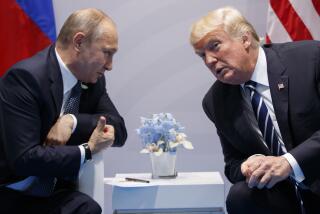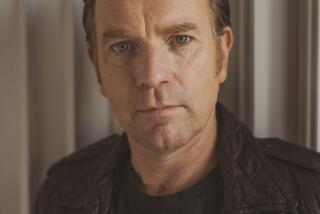‘Ron, Mikhail’ More Friendly Than in Past
- Share via
WASHINGTON — By Wednesday evening, it had become “Ron” and “Mikhail,” two husbands getting a laugh out of playing a little trick on their tardy wives.
The session in the Oval Office ran late, so President Reagan offered to give Soviet leader Mikhail S. Gorbachev a lift to the State Department to meet his wife, Raisa. When the leaders of the world’s most powerful nations got there, however, “We found out that Nancy and Raisa were having coffee together, and they were late,” Reagan later recalled.
“So when we stood down there . . . waiting for them to come down, I suggested something to him and we both did it--that when finally they came around and through the door, he and I were both looking at our watches.
“We got a laugh.”
Ronald Wilson Reagan, the President who came into office saying Communists “reserve unto themselves the right to commit any crime, to lie, to cheat,” and Mikhail Sergeyevich Gorbachev, who has been winning Communist Party honors since he was a teen-ager, are now on a first-name basis.
And their improving personal relationship is allowing the superpower leaders to explore some of the sensitive points dividing their countries more frankly and more safely, White House aides said. Because they know and like each other better, Reagan and Gorbachev are now able to press their points vigorously but avoid going too far and endangering the overall dialogue.
“They feel they know each other well enough to know the flash points between deep concern and anger, and they can talk candidly without it erupting into dangerous anger,” said one senior American official.
As portrayed by senior aides, the mood at the Washington summit is substantially warmer than the formal cordiality of Geneva in 1985 and a far cry from the animosity that marked the two leaders’ 1986 summit in Reykjavik, Iceland.
Gaps Still Exist
White House officials conceded Wednesday that the two did not, as a result of their improving personal rapport, bridge any of the wide gaps separating the United States and the Kremlin on such crucial issues as the Soviet military role in Afghanistan or the Persian Gulf--two key topics discussed at their meeting Wednesday. Nor does it preclude a damaging setback if substantive problems develop down the road.
Until Tuesday afternoon, when they signed a treaty eliminating the superpowers’ medium-range nuclear weapons arsenals, Reagan and Gorbachev had used formal forms of address: “Mr. General Secretary” and “Mr. President.”
That changed in a quiet moment after the ceremony when Reagan said to Gorbachev, “in working situations, my name is Ron.”
“My name is Mikhail,” Gorbachev replied.
“Maybe, in private session, we can go by first names,” Reagan responded.
And so it has gone, with evidence accumulating steadily through their two days of meetings that the Ron-and-Mikhail Show has been a considerably friendlier affair than its predecessors:
-- When Gorbachev’s Zil limousine pulled up the curved driveway of the White House on Wednesday morning at 10:30, there was Reagan, waiting for him outdoors rather than in the Oval Office. The two walked together up a stone path to the President’s office.
Spontaneous Gesture
-- After five waves of reporters and photographers had departed from the Oval Office, recording the relaxed scene as the two men sat in armchairs facing a crackling fire, the President--in what spokesman Marlin Fitzwater said was an “essentially spontaneous” gesture--suggested that the two adjourn to his private study nearby, accompanied only by translators but without note takers--enhancing the intimacy of the meeting.
A senior White House official said that the personal chemistry of Reagan and Gorbachev is valuable, even in the hard-edged world of superpower negotiations. In this view, the sort of warm personal relationship portrayed by both Fitzwater and Soviet Foreign Ministry spokesman Gennady I. Gerasimov can ease tensions even as the two explore contentious issues.
“They have a very comfortable relationship with each other on a personal basis that allows them to be tough in a policy and political basis,” the White House official said, speaking on the condition that he not be identified.
Marshall Shulman, a professor emeritus of international relations at Columbia University and a former special State Department adviser on Soviet affairs during the Carter Administration, said such personal relationships matter in superpower diplomacy, “particularly with these two men.”
Doesn’t Fit Stereotype
“Each has a rather personal style of policy-making,” he said. “Especially with the President, a great deal depends on his personal estimate of the man.”
The personal rapport that appears to have been established, he said, demonstrates that “Gorbachev doesn’t fit the President’s earlier stereotype of Soviet leaders. What seems to have struck him in Gorbachev is a new-style Soviet leader. That impression is a positive factor in the negotiations.”
Referring to the Reykjavik summit and the Geneva summit 11 months earlier, Shulman said Gorbachev “clearly has learned the lesson of earlier experiences.”
According to Shulman, the two “set each other off--they both got a little combative” in Geneva. But even at the time, Administration officials said that that summit allowed the leaders to break the ice of a five-year freeze in U.S.-Soviet relations and begin to establish a personal relationship.
But much of that progress was washed away in the flood of bad feelings that resulted when Gorbachev pressed Reagan to accept limits on the Strategic Defense Initiative in Reykjavik and the President refused.
“Now, they’ve learned what to press and what not to press,” Shulman said.
More to Read
Get the L.A. Times Politics newsletter
Deeply reported insights into legislation, politics and policy from Sacramento, Washington and beyond. In your inbox twice per week.
You may occasionally receive promotional content from the Los Angeles Times.










